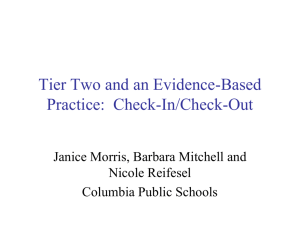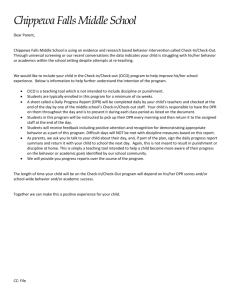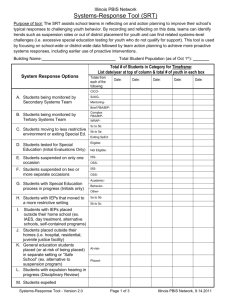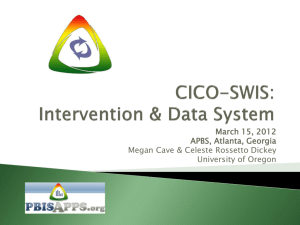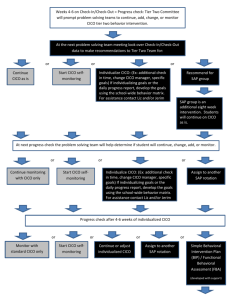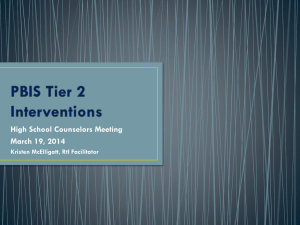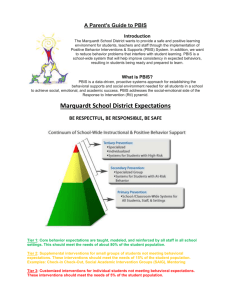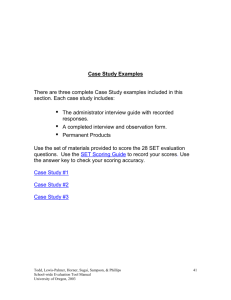CICO CEC Conference
advertisement
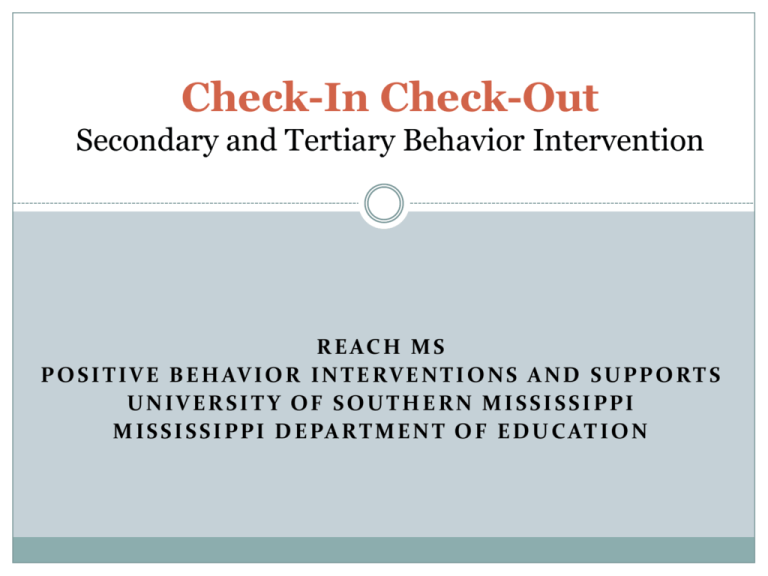
Check-In Check-Out Secondary and Tertiary Behavior Intervention R E AC H M S P O S I T I V E B E H AV I O R I N T E RV E N T I O N S A N D S U P P O RT S UNIVERSIT Y OF SOUTHERN MISSISSIPPI M I S S I S S I P P I D E PA RT M E N T O F E D U C AT I O N REACH MS PBIS Initiative… Realizing Excellence for ALL Children in Mississippi (REACH MS) is Mississippi’s State Personnel Development Grant which focuses primarily on supporting school-wide and district-wide implementation of Positive Behavioral Intervention and Support (PBIS) at the elementary, middle, and high school levels. Awarded to The Mississippi Department of Education in 2005, the grant is operated by the University of Southern Mississippi’s Department of Curriculum, Instruction and Special Education. 2 Goals Review School-Wide PBIS Define the logic and core features of Targeted Interventions Provide specifics of the Check-in/Check-out (CICO) approach for Tier 2 interventions Self-assess if CICO is appropriate for your school Provide details for modification of CICO for Tier 3 interventions What is Response to Intervention? Mississippi’s model for RtI is a comprehensive, problem solving and multi-tiered intervention strategy to enable early identification and intervention for ALL students who may be at academic or behavioral risk. MDE Response to Intervention Best Practices Handbook (2010) Mississippi Department of Education Response to Intervention Tier 1 Quality Instruction which describes the school-wide efforts and practices that are available to all students; including: Essential Elements 4) universal screening of behavior 8) classroom and behavior management 9) system of behavioral support (school & district level) MDE Response to Intervention Best Practices Handbook (2010) Blended Initiatives Behavioral Systems Academic Systems Intensive, Individual Interventions Specific students Targeted Group Interventions Targeted students Universal Interventions All students 1-5% 5-10% 80-90% Intensive, Individual Interventions Specific students 1- 5% 5-10% 80-90% Targeted Group Interventions Targeted students Universal Interventions All students Dr. George Sugai, Co-Director Center on PBS Levels of PBIS Adapted from Levels and Descriptions of Behavior Support (George, Harrower, & Knoster, 2003) School-Wide – Procedures and processes intended for all students, Tier 1 staff, in specific settings and across campus Classroom – Processes and procedures that reflect school-wide expectations for student behavior coupled with pre-planned strategies applied within classrooms Target Group – Processes and procedures designed to address behavioral issues of groups of students with similar behavior problems or behaviors that seem to occur for the same reasons (i.e. attention seeking, Tier 2 escape) Individual Student – Processes and procedures reflect school-wide expectations for student behavior coupled with team-based strategies to Tier 3 address problematic behaviors of individual students 7 “All specialized interventions are more effective, and more durable, if they are done with school-wide behavioral expectations as a foundation.” Horner, Sugai, et al. “Check-In Check Out: A Targeted Intervention” www.pbis.org School-Wide Positive Behavior Support ~5% Tertiary Prevention: Specialized Individualized Systems for Students with High-Risk Behavior CICO Secondary Prevention: Primary Prevention: School-/ClassroomWide Systems for All Students, Staff, & Settings ~15% ~80% of Students Specialized Group Systems for Students with At-Risk Behavior Horner & Sugai, 2007 What is School-Wide Positive Behavior Interventions and Supports School wide system of support Proactive strategies Define, teach and support appropriate student behavior Create positive school environments School-Wide PBIS Consists of: Rules, routines and physical arrangements that are developed, taught and rewarded to prevent problem behaviors School-Wide PBIS focuses on making: desired behaviors more functional and problem behaviors less functional The goal is to create and maintain a climate in which appropriate behavior is the norm. PBS involves: Teaching students how you want them to behave Reinforcing them when they do behave appropriately Critical Elements of PBIS Expectations Rules Teaching Reinforcement System Using Data to Create Long-Term Change Tier 2 Interventions Target Students with 2-5 ODRs Major Features of Targeted Interventions Continuously available Quickly initiated (72 hr) Easy for teachers to implement Consistent with school-wide expectations All staff/faculty can implement Can be linked from school to home Adequate resources (admin, team) Continuous monitoring for decision-making Check-In Check-Out (CICO) Designed to provide support and monitoring for students at-risk of developing serious or chronic behavior problems Characteristics of students who are good candidates for Check-in/Check-out Not responding successfully to School-Wide PBIS system Adult attention seeking Problem behavior throughout multiple settings Mild acting out (not a threat to self or others) (Horner, Hawken, March ) Components of Check-in Check-out Goals/expectations are developed and are monitored daily with a point card Same expectations for all Common schedule All staff taught rules for accepting, completing and returning the card. Instruction on expectations Daily check-in before school and check-out at end of the day with a positive adult mentor Regular check-in with teachers during the day to complete point card Data system to monitor student progress (Horner, Hawken, March ) CICO Record Name: ____________________________ 3 = great Date: ______________ 2 = good Safe Goals 1 = hard time Responsible Respectful Check In 3 2 1 3 2 1 3 2 1 Before Recess 3 2 1 3 2 1 3 2 1 Before Lunch 3 2 1 3 2 1 3 2 1 After Recess 3 2 1 3 2 1 3 2 1 Check Out 3 2 1 3 2 1 3 2 1 Today’s goal 20 Today’s total points Gale-Bailey Elementary School Gale-Bailey Elementary School Benefits of point card For staff Reminder for specific feedback to student For student Reminder of schedule for day Reminder of specific behavioral expectations and goals for the day Opportunity to self-recruiting feedback from teachers and parents Progress monitoring tool For school Provides data for progress monitoring Communication Check-in Check-out Cycle CICO Plan Morning Check-In Class Check out Teacher Checks Home Check-In Class Check in Afternoon Check-out EXIT (Horner, Hawken, March ) What does it look like? Morning Check-In Location is consistent Greet student positively Prompt for point card Make sure student is prepared for day breakfast, planner, pencil, etc. Review expectations http://vimeo.com/19399257 (Horner, Hawken, March ) What Does It Look Like? Throughout the day Criteria is established for points Student carries point chart Teacher greets and pre-corrects Teacher provides feedback and records points http://vimeo.com/20074101 Positive Feedback http://vimeo.com/20073355 Corrective Feedback (Horner, Hawken, March ) What Does It Look Like? Check-Out Location is consistent Greets student positively Student totals points and determines percentage Daily and/or weekly reward given for meeting goals Debrief and parent note http://vimeo.com/19402368 (Horner, Hawken, March ) So… The student knows what is expected Student receives attention throughout the day for meeting these expectations Parents provide attention for meeting expectations Self-monitoring skills are developed Connection to Home Home report process Can be same as point sheet Can be a different form Keeps parent informed of behavior at school Parents should not reprimand or scold student for unsuccessful day Parent can provide additional reinforcement at home when child meets daily or weekly goal. CICO Home Report Name: _____________________________ Date: _____________ ______ I met my goal today ______ I had a hard day One thing I did really well today was:_______________________ Something I will work on tomorrow is: _______________________ Comments: Parent/Guardian Signature: ________________________________________________________ Comments: Why Does CICO Work? Structure is Improved Success is Built In Contingent Feedback is Increased Intervention can be applied in all school locations Appropriate behavior is rewarded more frequently Behavior support and academic support can be linked Linking school and home support Program can be modified for self-management (Horner, Hawken, March ) Is Your School Ready for CICO? Is School-Wide PBIS in place? Are problem behaviors a major concern for administration and staff? Do more than 5 students need extra behavioral support? CICO is designed to work with 10-12% of kids in a school CICO is typically effective fore 67% of students. CICO does NOT replace need for individualized supports. Are staff willing to commit 5 minutes per day? Roles and Responsibilities School team Meets at least every 2 weeks Identifies students who may be appropriate for CICO Monitors implementation Modify/fade intervention based on student progress data Coordinator Facilitates morning check-in and afternoon check-out Gets point sheets from students and gives new form each morning Maintains positive, constructive interactions with the student Celebrates successes with the student Anderson and Todd: “Check-In Check Out” www.pbismaryland.org/documents/AndersonCICO.ppt Roles & Responsibilities (cont.) Teachers Obtain form from student each day Monitor student and completes card according to student behavior Provide feedback to student in positive and constructive manner Students Check in and out each day Give form to teacher Meet expectations Take form home and have parents sign, bring to school the next day Anderson and Todd: “Check-In Check Out www.pbismaryland.org/documents/AndersonCICO.ppt Considerations: Morning Check-In Routine Teaching student when, where, how Teaching check-in coordinator Assess Reward Set-up for success and Redirect Teacher Check-in/Check-out Routine Teach student when, where, how Teach faculty/staff Reward Set-up for success Evaluation Horner, Sugai, et al. “Check-In Check Out: A Targeted Intervention” www.pbis.org Considerations: Afternoon Check-Out Routine Teaching student when, where, how Teach CICO coordinator data collection, acknowledge success, encourage improvement. Consider self-recording system for older students Family Review Routine Teach student when, where, how Teach family only to acknowledge success, sign Horner, Sugai, et al. “Check-In Check Out: A Targeted Intervention” www.pbis.org Considerations: Trading Menu/ Process Menu/ Process Reward for collecting and turning in daily progress report information Reward for meeting daily goal Exchange system for points earned? Horner, Sugai, et al. “Check-In Check Out: A Targeted Intervention” www.pbis.org What to do with those points? Peer Attention Adult Attention Task Avoidance Individual Choice Classroom rewards Lunch with favorite adult Time along in activity of choice Prize from treasure box Choose partner for an activity Special time with favorite adult Get out of class early Computer time Sit by friend at lunch Call to parent Break, shortened work requirement Being Leader Brief free time with friend Reading with a favorite adult Check out with friend Help a favorite teacher Extra PE or other special Free choice of activity CICO Trading Post Wants attention Wants item/activity Wants to escape attention Wants to avoid something 100 pts •Take note to office/teacher •Ask a peer to play/read/draw •Be a leader •Principals recess •Trip to treasure chest •Choose a snack •Choose a 5 min. activity •School wide sticker •Principals recess •Computer time by self •Short break •Alternative activity 250 pts •Computer with a friend •Extra sharing time •More time for selected activity •Free ticket to sporting event •Time alone •Independent work space •Alternative assignment 400 pts •Out to lunch with TBA •Class recess, free time, or popcorn party •New school /art supplies • Extended time alone •Get out of school early Points Required 39 Additional Considerations: • Planning for Success o How does a student move off of CICO o Modifying for self-management • Moving to Individual Behavioral Support o Functional behavioral assessment o Comprehensive behavior support • Substitute Teacher use of CICO o How do you train substitutes? • Utilizing CICO on the playground, cafeteria and bus Horner, Sugai, et al. “Check-In Check Out: A Targeted Intervention” www.pbis.org Plan for the future: Self-managers Based on students progress, consider modifying for self-management Use natural signals for monitoring as much as possible Self-monitor behavior Self-record, check for accuracy Fewer check points during the day Maintain AM and PM times for awhile Manage own CICO account Horner, Sugai, et al. “Check-In Check Out: A Targeted Intervention” www.pbis.org CICO Component of SWIS School-Wide Information System (SWIS) provides a data collection system for CICO Allows for progress monitoring of individual students and groups of CICO students 43 Check-in/ Check-out Self-Assessment Individually score the elements of the CICO Self- Assessment In place; In progress; Not in place As a team review your ratings, and agree on a single summary for the school For elements not scored as “in place” define the actions that will move you toward implementation. Who will do what, when? Define a schedule for meeting to review progress and implement your CICO plan. Horner, Sugai, et al. “Check-In Check Out: A Targeted Intervention” www.pbis.org CICO Self- Assessment Tier 3 Interventions Target Students with 6+ ODRs CICO Individualized for Tier 3 Interventions Any CICO program can be modified to meet individual needs of students Based on results of Functional Behavior Assessment Expectations modified for specific behavioral needs of student More frequent checks with mentor More frequent individualized reinforcement Typically used in combination with skills building (i.e., social skills, anger management, etc.) CICO Record Name: ____________________________ 3 = great Date: ______________ 2 = good 1 = hard time Be Respectful Hands to self Be Responsible Finish all work Check In 3 2 1 3 2 1 3 2 1 Before Recess 3 2 1 3 2 1 3 2 1 Before Lunch 3 2 1 3 2 1 3 2 1 After Recess 3 2 1 3 2 1 3 2 1 Check Out 3 2 1 3 2 1 3 2 1 Goals Today’s goal Today’s total points 49 Parent/Guardian Signature: _________________________ Be Safe Keep chair legs on floor HAWK Report Student _______________Teacher___________________ Date ________ Be Safe 0 = Not Yet 1= Good 2= Excellent Be Respectful Keep hands, feet, and objects to self Be Your Personal Best Teacher initials Use kind words and actions Follow directions Class 0 1 2 0 1 2 0 1 2 Recess 0 1 2 0 1 2 0 1 2 Class 0 1 2 0 1 2 0 1 2 Lunch 0 1 2 0 1 2 0 1 2 Class 0 1 2 0 1 2 0 1 2 Recess 0 1 2 0 1 2 0 1 2 Class 0 1 2 0 1 2 0 1 2 Total Points = Points Possible = Today ______________% 50 Working in class 0 1 2 0 1 2 0 1 2 0 1 2 Goal ______________% Adaptations and Variations Todd, A. (2010) Check-in Check-Out: The Intervention CICO element Variations/ options Issues of concerns 1. Check in Check out staff Educational/instructional assistant School counselor High school mentor Consistency Efficiency One person or two Freeing up time for person to do the job well 2. Check in/out routine Come to school early Leave class early Same location/different locations What about tardy students Missing instruction time How does it work for busers, walkers, car riders? 3. Point system and daily report card Numbers/words/smiley faces 0, 1, 2 1, 2, 3 great, OK, bad (difficult time) Age appropriate I get a point for being honest/ trying (1, 2 , 3) 4. Report home Meet with parents individually as part of the CICO training Provide ideas for comments to write back, things to say to student, how to deal with a bad day Staff mentor signs off if family can’t Parents might correct kid again Student may forge parent signature 5. Identifying students to participate Final recommendation by TAT Review of ODRs, teacher concern, family request, student request, administrator request Avoid reacting to make this a ‘punishment’ 6. Staff training A few at a time (start small to build routine & success) All at once Efficiency in teaching time Won’t remember unless using CICO What happens when a student gets an office discipline referral? Adaptations and variations (continued) 7. Student training As a group Individually Daily prompts for routine the first five days What to do if staff/teacher isn’t available Teach students to remind staff/teachers to use program Loss of card during the day 8. Substitute staff Train a back up check in and check out person Rotate roles so many people can contribute as needed Administrator Front office staff for tardy students CICO cheat sheet for substitute teacher folder Lack of opportunity to maintain fluency, positive practice, consistency Prevent punitive approach 9. Point trading system Spending schedule Need a variation of items/activities to fit many situations Discounted school activities work really well Prizes/activities for whole class are great for kids who like peer attention Too often Not often enough Student absent on spending day Financial costs for rewards Time costs for staff who are ‘earned’ 10. Team meeting to review student progress Weekly data review, call a meeting as needed Email check in with teachers/families Coordinator not available/ no meeting… no meeting/ no data review…. No data review.. program and/or kid get a bad name if it doesn’t work Some Research Articles Hawken, L. S. & Horner R. H., (2003) Implementing a Targeted Group Intervention Within a School-Wide System of Behavior Support. Journal of Behavioral Education, 12, 225-240. March, R. E. & Horner, R. H. (2002) Feasibility and contributions of functional behavioral assessment in schools. Journal of Emotional and Behavioral Disorders, 10, 158-70. Resources for Implementing the BEP Crone, Horner, & Hawken (2004). Responding to Problem Behavior in Schools: The Behavior Education Program. New York, NY: Guilford Press Hawken, Pettersson, Mootz, & Anderson (2006). The Behavior Education Program: A Check-In, Check-Out Intervention for Students at Risk. New York, NY: Guilford Press © 2005 by The Contact Information: Sydney Wise REACH-MS sydney.wise@usm.edu www.usm.edu/reachms
